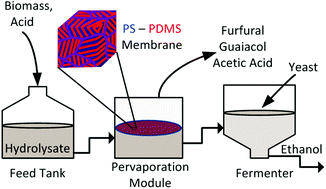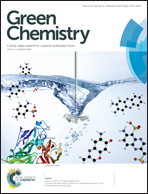Fermentation of hydrolysate detoxified by pervaporation through block copolymer membranes†
Abstract
The large-scale use of lignocellulosic hydrolysate as a fermentation broth has been impeded due to its high concentration of organic inhibitors to fermentation. In this study, pervaporation with polystyrene-block-polydimethylsiloxane-block-polystyrene (SDS) block copolymer membranes was shown to be an effective method for separating volatile inhibitors from dilute acid pretreated hydrolysate, thus detoxifying hydrolysate for subsequent fermentation. We report the separation of inhibitors from hydrolysate thermodynamically and quantitatively by detailing their concentrations in the hydrolysate before and after detoxification by pervaporation. Specifically, we report >99% removal of furfural and 27% removal of acetic acid with this method. Additionally, we quantitatively report that the membrane is selective for organic inhibitor compounds over water, despite water's smaller molecular size. Because its inhibitors were removed but its sugars left intact, pervaporation-detoxified hydrolysate was suitable for fermentation. In our fermentation experiments, Saccharomyces cerevisiae strain SA-1 consumed the glucose in pervaporation-detoxified hydrolysate, producing ethanol. In contrast, under the same conditions, a control hydrolysate was unsuitable for fermentation; no ethanol was produced and no glucose was consumed. This work demonstrates progress toward economical lignocellulosic hydrolysate fermentation.



 Please wait while we load your content...
Please wait while we load your content...